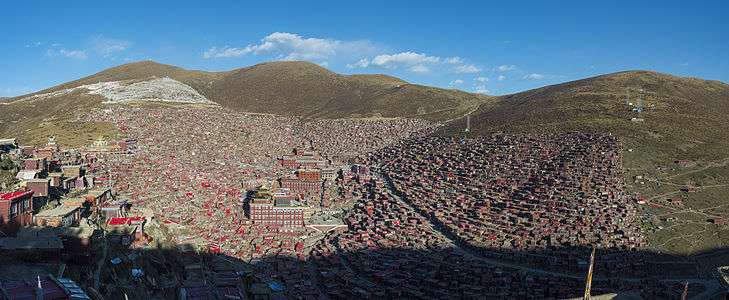Larung Gar Buddhist Academy




In 1980, Khenpo Jigme Phuntsok founded the Larung Ngarig Buddhist Academy (Tibetan: བླ་རུང་ལྔ་རིག་ནང་བསྟན་སློབ་གླིང་།, ZYPY: Larung Ngarig nangdän lobling , Chinese: 喇荣五明佛学院; pinyin: Larong Wuming foxueyuan), in the Larung Valley (喇荣沟) near the township of Larung in Sêrtar County, Garzê Prefecture, Sichuan Province. The purpose of the Institute has been to provide an ecumenical training in Tibetan Buddhism and to meet the need for renewal of meditation and scholarship all over Tibet in the wake of China’s Cultural Revolution of 1966-76.[1]
Despite its remote location, it grew from a handful of disciples gathering in Khenpo's home to be one of the largest and most influential centers for the study of Tibetan Buddhism in the world, numbering to nearly 10,000 monks, nuns, and lay disciples by the year 2000.
Demographics
Overall, the student body of Larung Five Sciences Buddhist Academy was made up of monks, nuns, lay "vow-holders" of both Tibetan and Chinese origins, and tantric practitioners. They studied under four major religious divisions in the Academy: Ngarig Nangten Lobling, International Religious Committee, Pema Khandro Duling Nunnery, and Lektso Charbeb Ling. Ngarig Nangten Lobling consisted of 2,500 Tibetan monks. Lektso Charbeb Ling is the section that trained over 1,000 lay Tibetan "vow-holders" and tantric practitioners from Sêrtar and other regions of Tibet.
Pema Khandro Duling Nunnery was the home for study to approximately 3,500-4,000 nuns from all regions of Tibet. More than half of those who came to Sertar were women and the curriculum allowed nuns to achieve a coveted Khenpo degree for the first time in Tibetan history. Entry into the relatively small number of nunneries that exist in other areas of Tibet is limited, but Sertar was open to virtually anyone who genuinely sought to become a student of Khenpo Jigme Phuntsok’s ecumenical vision. Khenpo’s niece, Jetsunma Mumso, was recognized as a tulku and heads the order of nuns. The term is descriptive of certain teachers in Tibet who are thought to reincarnate over a number of generations.
Roughly ten percent of the nearly 10,000 students attending Sertar were ethnic Han people. They attended separate classes taught in Standard Chinese while larger classes were taught in Amdo Tibetan. The International Religious Committee oversaw 1,000 disciples from regions of the People’s Republic of China and students from other Asian countries.
History
The Sertar Institute operates with a standing executive committee of seven learned lamas, but major decisions are confirmed and implemented only after consultation with Khenpo Jigme Phuntsok. The Sertar Institute has been home to over 500 khenpos — holders of Doctoral degrees in divinity — and is widely renowned for the high quality of both its religious and secular education. English, Chinese, and Tibetan languages and modern computer studies have been taught alongside a traditional non-sectarian Buddhist curriculum.
The Chinese demolished about 2,000 huts in 2001, "because of concerns about social stability" at the site, simultaneously limiting the population to 1,400 residents.[2] More than 1,000 new huts are constructed every year by both professional crews and monks and nuns themselves with the help of their families and friends.
In February 2016, a photograph of Larung Gar by Hungarian photographer Attila Balogh was shortlisted for that year’s Sony World Photography Awards.[3]
On 22 July 2016, the BBC reported evidence from the campaign group Free Tibet that a government work team, accompanied by Chinese police and plainclothes members of the armed forces, had begun to demolish more buildings at Larung Gar in response to an order made the previous month by local authorities.[4] The Los Angeles Times noted that the demolition was being carried out after "two major government meetings during which President Xi Jinping stressed “national unity” and the necessity for religious groups to support the Communist Party and “merge their religious doctrines with Chinese culture.”" L[Robert] Barnett [a Tibet scholar at Columbia University] said this was indicative of the social unrest in Tibet, quoted in the LA Times as saying "We’ve had — what is it? — five years of self-immolations, massive protests in 2008 and so on. The language of resistance is rife throughout China and Tibet."[5]
Tourism
Larung Gar is outside the main tourist routes and few foreigners find their way there. Occasionally officials have prevented foreigners from visiting the institute, but in recent years it has been mostly accessible. There is one hotel on the Northern ridge line, which is most easily reached via the new construction access road from the north, avoiding the congestion on the narrow streets of the institute. There are also a simple guesthouse and a few restaurants on the main square next to the main Gompa. A new "Temple of Death" has been built at the sky burial site about one kilometer north of the institute.
References
- ↑ Faison, Seth (28 July 1999). "A 'Living Buddha' Plants an Academy". New York Times. Archived from the original on 6 January 2014. Retrieved 18 March 2013.
- ↑ Eckholm, Erik (22 June 2001). "Monitors Say China Pushes Tibet Monks From Study Site". New York Times. Retrieved 21 June 2016.
- ↑ "Sony World Photography Awards 2016: the final shortlist". The Guardian. London. 23 February 2016. Retrieved 22 July 2016.
- ↑ "Larung Gar: China 'destroys buildings' at Tibetan Buddhist academy". BBC News Online. 22 July 2016. Retrieved 22 July 2016.
- ↑ Makinen, Julie (22 July 2016). "For 2nd time in 15 years, Tibetan Buddhist academy faces demolition order". Los Angeles Times. Los Angeles. Retrieved 22 July 2016.
External links
- Larung Ngarig Buddhist Academy - About us - International Buddhist Association (with Prospective Student Registration link)
Coordinates: 32°09′10″N 100°28′08″E / 32.1528°N 100.4689°E